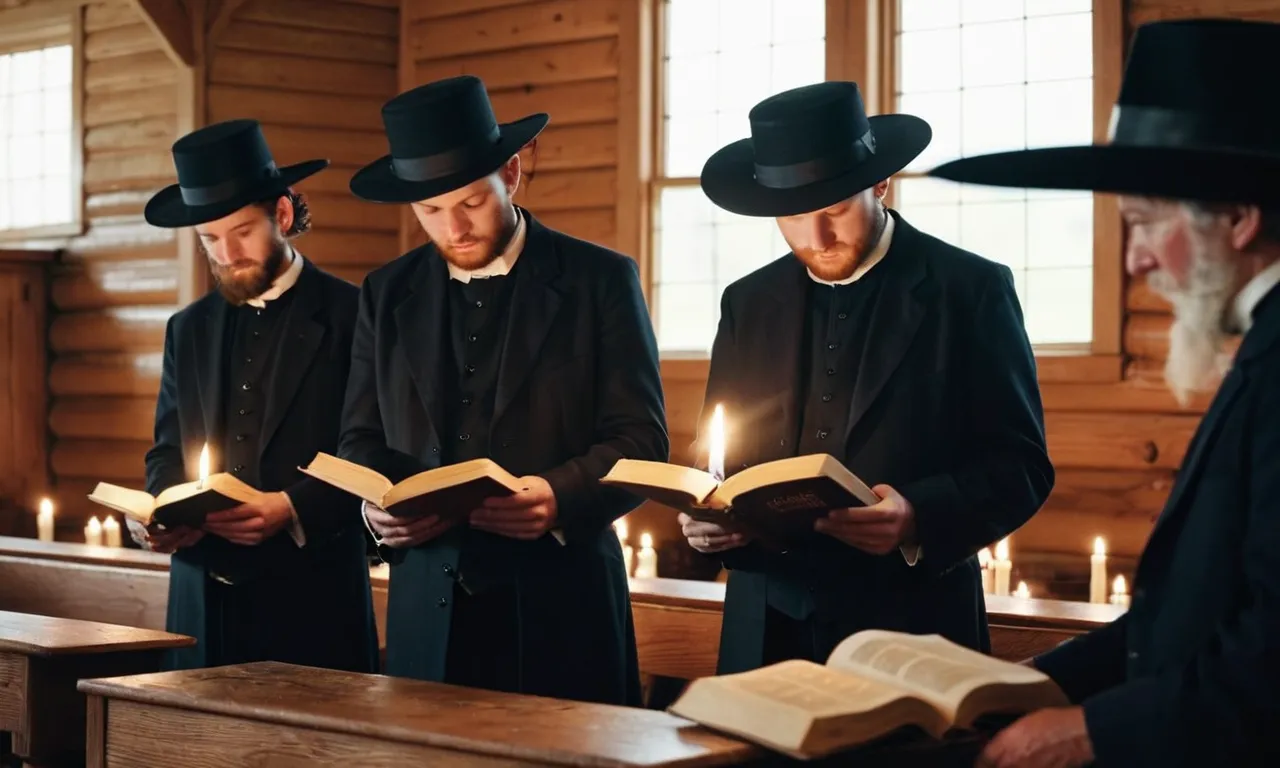What Bible Do The Amish Use?
The Amish are a traditional Christian group known for their simple way of life and avoidance of modern conveniences. When it comes to faith, the Bible plays a central role in Amish worship and practice. But what translation of the Bible do the Amish actually read and follow?
If you’re short on time, here’s a quick answer to your question: The Amish typically use the German Luther Bible translation for worship and study. Most Amish are fluent German speakers and read scripture in that language.
In this comprehensive guide, we’ll take a close look at the Bibles used by the Amish community. We’ll cover the different translations they rely on, examine why the German Luther Bible holds such importance, and outline other versions sometimes used among Amish groups.
The German Luther Bible
Origins and history
The German Luther Bible has a long and storied history dating back to the Protestant Reformation in the 16th century. When Martin Luther translated the New Testament into German in 1522, he sought to make the Bible accessible to common people in their own native language.
At the time, the Bible was available mainly in Latin, restricting scripture reading to educated clergy and academics. Luther’s German New Testament was monumental, allowing German speakers to read the scriptures for themselves for the first time.
Luther and his associates went on to translate the entire Bible into German between 1522 and 1534. This first complete German Bible is known as the Luther Bible. It drew on Luther’s New Testament translation, the Latin Vulgate edition, and other sources.
The Luther Bible was illustrated by prominent artists, making it widely appealing. It was an immediate bestseller, with thousands of copies printed in its first decade alone.
The Luther Bible profoundly shaped the German language and culture. By making the scriptures accessible to the common people, it standardized modern High German and aided the development of a common German national identity.
It introduced universal phrases and idioms into German and became a cultural landmark.
The Luther Bible has undergone several revisions over the centuries. Major editions include the Luther Bible of 1534, the Luther Bible of 1912, and the modernized Luther Bible of 2017. Though details of translation have been updated, the essence of Luther’s seminal 16th century translation remains intact to this day.
Significance and use among the Amish
For Amish Christians, the Luther Bible holds special significance. Most Amish use the Luther Bible, specifically the 1912 edition, as their religious text. This edition sticks closely to Luther’s early modern German translation while updating spelling and grammar for contemporary readers.
The Amish adopted the Luther Bible as their own during the Protestant Reformation. For hundreds of years, this Bible has shaped Amish worship, theology, and Christian instruction. Amish ministers still preach from the Luther Bible today.
It is central to Amish religious services, used alongside the Ausbund hymnal.
For the Amish, the Luther Bible provides continuity and connection to their Anabaptist heritage and European roots. It represents important religious values like simplicity, obedience, and separation from the world. While English Bibles are available, the Luther Bible remains authoritative.
Amish children memorize verses from it, and adults study the print intently. Families treasure Luther Bible editions passed down for generations.
The Luther Bible’s antiquated language reinforces Amish culture and tradition. It contains words and phrases not found in modern English versions. Maintaining this edition is one way the Amish resist change and outside influence.
For over 400 years, the Luther Bible has been foundational to Amish faith – a fact that remains unchanged in the 21st century.
Other Translations
English Standard Version (ESV)
The English Standard Version (ESV) is another popular modern English translation used by some Amish groups. The ESV was first published in 2001 by Crossway, a division of Good News Publishers. It is based on the 1971 Revised Standard Version and aims to be a literal, word-for-word translation.
Here are some key things to know about the ESV:
- The translation philosophy is focused on word-for-word accuracy and being faithful to the original Greek and Hebrew texts.
- The ESV uses formal equivalence translation instead of dynamic equivalence. This makes it read more literal and less interpretive.
- The ESV is seen as a revision of the RSV that removes some of the liberal gender-inclusive language.
- The ESV has received endorsements from prominent evangelical scholars and leaders.
- The ESV is growing in popularity in Amish communities. Some groups appreciate its literal accuracy.
- Some Amish see the ESV as a more modern alternative to the KJV, while maintaining a formal translation approach.
The ESV is often appreciated by Amish for its focus on accuracy and literal faithfulness to the original biblical texts. Some groups have switched to the ESV because they consider it an improvement over the RSV. However, other Amish still prefer the familiarity and tradition of the KJV.
King James Version (KJV)
The King James Version (KJV) of the Bible is the most widely used translation among Amish groups. The KJV was originally published in 1611 and remains the preferred Bible version for many Amish today.
Here are some key facts about Amish use of the KJV:
- The vast majority of Amish church services and Sunday Schools use the KJV.
- Amish typically preach and memorize Scripture from the KJV.
- Many Amish believe the KJV is the most accurate English translation available.
- The KJV uses formal, elevated language that the Amish appreciate.
- Some Amish view newer translations with skepticism and prefer the familiar KJV.
There are several reasons why the KJV remains the standard Bible version for Amish communities:
| Reason | Explanation |
|---|---|
| Tradition | The KJV has been used for centuries and is seen as the true, original Bible text. |
| Familiar Language | Amish are extremely familiar with the language and phrasing of the KJV. |
| Uniformity | Using the same translation promotes unity and consistency. |
| Formal Style | Amish appreciate the formal, reverent language of the KJV. |
| Availability | KJV Bibles are widely available, inexpensive, and come in study editions. |
Differences From Protestant Bibles
The Bible used by the Amish has some key differences compared to the Bibles used by many Protestant denominations. Here are some of the main ways the Amish Bible diverges from common Protestant versions:
Older Translation
The Amish primarily use the German Luther Bible translation from the 1500s. This predates the King James Version and other more modern English translations. The Amish chose to retain this older German text rather than adopting newer interpretations.
Extra Books
The Amish Bible contains the Apocrypha, a collection of books that were removed from many Protestant Bibles. These books, such as Tobit, Judith, and Maccabees, are considered canonical by the Amish but not by most Protestant groups.
Higher German Language
While the Amish speak Pennsylvania Dutch, a variant of German, their Bible utilizes High German. This traditional biblical language preserves the cultural heritage for the Amish even as their day-to-day German dialect evolved over time in America.
Annotations and Commentaries
Many Protestant Bibles contain explanatory footnotes and cross-references to other passages. However, the Amish Bible has no additional annotations or commentary beyond the scriptural text itself. The Amish believe the Bible should be interpreted directly without notes swaying the meaning.
Excluded Books
A few books commonly found in Protestant Bibles are not part of the Amish Bible. For example, the Amish do not recognize 2 Peter, Jude, Revelation and sometimes Acts as canonical scripture the way other Christian groups do.
Bible Study and Memorization
The Amish place a strong emphasis on Bible study and memorization. The Bible serves as the foundation for their faith, guiding their beliefs, practices, and way of life. Here is an overview of how the Amish approach Bible study:
Daily Bible Readings
Most Amish make it a point to read the Bible every day, both individually and as families. They believe consistent study of scripture is critical for spiritual growth and remaining faithful to God. Amish families often read the Bible together in the morning before beginning their day and again in the evening before bed.
Memorization
Amish children begin memorizing Bible verses from an early age. They are taught short passages from the Bible in school and are expected to recite them from memory. Adults also emphasize Bible memorization and reference verses from memory frequently.
Passages from the New Testament, Psalms, and Proverbs are among the most commonly memorized.
In-Depth Study
In addition to daily readings, Amish church members engage in lengthy Bible studies, especially in preparation for biannual communion services. These studies may examine a particular Biblical theme or book over the course of several months.
Sunday school classes also promote in-depth study of scripture.
Using the Bible in Daily Life
Beyond formal study, the Amish strive to apply Biblical principles to every aspect of their daily lives. They reference scripture when making important decisions, offer Biblical counsel to one another, and teach scriptural wisdom to their children.
Amish church leaders emphasize linking Bible study to concrete actions and lifestyle choices.
Emphasis on Obedience
For the Amish, the purpose of Bible study is not just to acquire knowledge, but to become obedient followers of God. They view scripture as containing clear instructions for right living. Regular Bible study serves as a moral compass and motivates them to align their lives fully with Biblical values and precepts.
Conclusion
For the Amish, the Bible serves as the foundation for their faith, guiding their religious practice, traditions, and way of life. While the German Luther Bible remains central to worship and study, some Amish groups have slowly adopted more modern English translations.
Yet across all Amish communities, scripture is regarded with utmost importance. Through bible study, memorization, and application of biblical principles, the Amish aim to live their lives according to God’s word.








